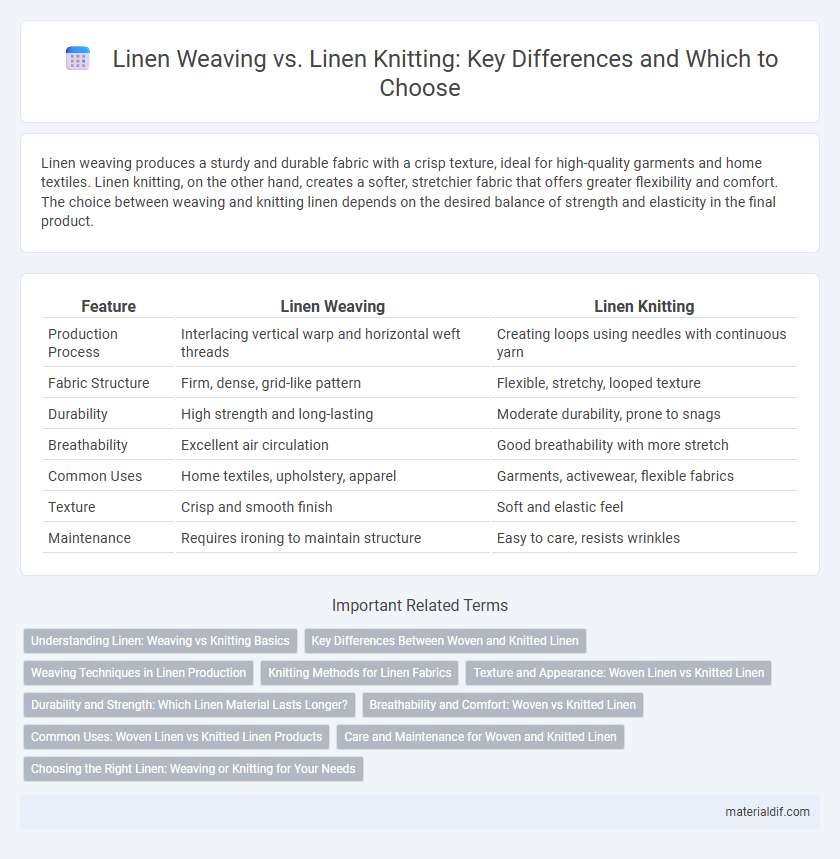Linen weaving produces a sturdy and durable fabric with a crisp texture, ideal for high-quality garments and home textiles. Linen knitting, on the other hand, creates a softer, stretchier fabric that offers greater flexibility and comfort. The choice between weaving and knitting linen depends on the desired balance of strength and elasticity in the final product.
Table of Comparison
| Feature | Linen Weaving | Linen Knitting |
|---|---|---|
| Production Process | Interlacing vertical warp and horizontal weft threads | Creating loops using needles with continuous yarn |
| Fabric Structure | Firm, dense, grid-like pattern | Flexible, stretchy, looped texture |
| Durability | High strength and long-lasting | Moderate durability, prone to snags |
| Breathability | Excellent air circulation | Good breathability with more stretch |
| Common Uses | Home textiles, upholstery, apparel | Garments, activewear, flexible fabrics |
| Texture | Crisp and smooth finish | Soft and elastic feel |
| Maintenance | Requires ironing to maintain structure | Easy to care, resists wrinkles |
Understanding Linen: Weaving vs Knitting Basics
Linen weaving involves interlacing warp and weft threads at right angles to create a strong, durable fabric with a crisp texture ideal for upholstery and home textiles. Linen knitting, by contrast, loops yarns together, resulting in a stretchier, softer fabric often used for comfortable garments and casual wear. Understanding these fundamental differences helps in selecting the appropriate linen textile based on desired texture, durability, and application.
Key Differences Between Woven and Knitted Linen
Linen weaving produces a crisp, durable fabric with a structured texture due to perpendicular interlacing of warp and weft threads, ideal for garments requiring shape retention and strength. Knitted linen features interlooped yarns creating a stretchy, flexible fabric that offers enhanced comfort and breathability, suitable for form-fitting clothing and casual wear. The key differences lie in durability, elasticity, and texture, with woven linen excelling in firmness and knitted linen in softness and stretchability.
Weaving Techniques in Linen Production
Linen weaving involves interlacing warp and weft threads at right angles to create a firm, durable fabric ideal for high-quality textile products. This technique enhances the natural strength and breathability of flax fibers, resulting in linen that is both sturdy and smooth with a distinct texture. In contrast to knitting, weaving produces a tighter, less stretchy fabric that maintains its shape and longevity under repeated use.
Knitting Methods for Linen Fabrics
Linen knitting involves interlocking loops of flax fibers to create flexible, breathable fabrics often used in apparel and home textiles. Circular knitting and flat knitting are common methods, providing stretch and durability while maintaining linen's natural texture and moisture-wicking properties. Knitting linen requires careful control of tension and needle size to accommodate the fiber's stiffness compared to softer yarns.
Texture and Appearance: Woven Linen vs Knitted Linen
Woven linen features a distinct, crisp texture with a tight, structured appearance, showcasing the natural slubs and matte finish characteristic of flax fibers. Knitted linen, in contrast, offers a softer, stretchier feel with a more relaxed and flexible drape, enhancing comfort and casual wear appeal. The visual difference lies in the woven linen's grid-like, firm pattern versus the knitted linen's looped, porous surface, affecting both durability and aesthetic versatility.
Durability and Strength: Which Linen Material Lasts Longer?
Linen weaving produces fabric with a tighter, more uniform structure that enhances durability and long-term strength compared to linen knitting, which tends to have a looser, more elastic texture prone to stretching and wear. Woven linen fibers maintain their integrity through repeated use and washing, making woven linen products last significantly longer than knitted counterparts. For applications requiring robust performance and longevity, woven linen is the preferred choice due to its superior resilience and minimal deformation over time.
Breathability and Comfort: Woven vs Knitted Linen
Linen weaving produces a tight, structured fabric that enhances breathability by allowing air to flow through the natural fibers, making it ideal for warm climates. Knitted linen offers greater stretch and softness, providing superior comfort and flexibility but with slightly reduced airflow compared to woven linen. The choice between woven and knitted linen depends on the desired balance of breathability and comfort for specific clothing or textile applications.
Common Uses: Woven Linen vs Knitted Linen Products
Woven linen is commonly used for products requiring durability and structure, such as tablecloths, curtains, and upholstery, thanks to its tight weave and strength. Knitted linen, with its flexibility and softness, is preferred for apparel like lightweight sweaters, tops, and breathable summer garments that benefit from stretch and comfort. The distinct production techniques influence the fabric's texture and function, making woven linen ideal for home textiles and knitted linen optimal for fashion wear.
Care and Maintenance for Woven and Knitted Linen
Woven linen requires gentle washing in cool water and should be air-dried or tumble-dried on low to maintain fabric integrity and avoid shrinkage, while knitted linen benefits from hand washing to preserve its elasticity and softness. Both woven and knitted linen should be ironed while damp to restore smoothness and prevent wrinkles, with woven linen needing a slightly hotter iron setting compared to knitted linen. Storing linen in a dry, well-ventilated area prevents mold and mildew growth, ensuring the longevity of woven and knitted linen garments.
Choosing the Right Linen: Weaving or Knitting for Your Needs
Linen weaving produces a durable, tightly constructed fabric ideal for upholstery and heavy-duty applications, while linen knitting offers greater stretch and breathability, making it perfect for apparel and lightweight textiles. Choosing the right linen depends on the intended use, with woven linen providing firmness and longevity, and knitted linen delivering comfort and flexibility. Consider the specific requirements of durability, texture, and elasticity to select between weaving and knitting for optimal linen performance.
Linen Weaving vs Linen Knitting Infographic

 materialdif.com
materialdif.com